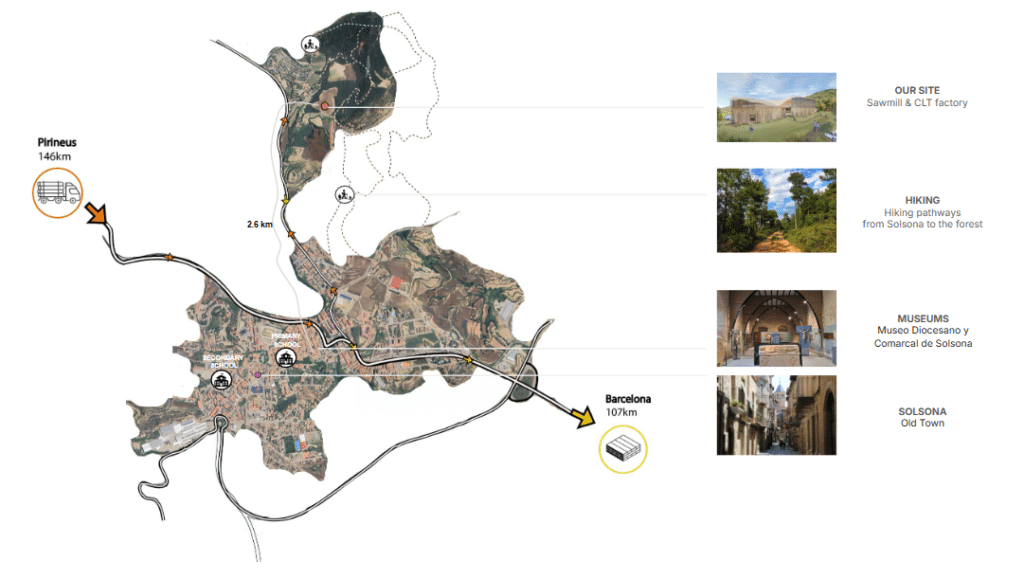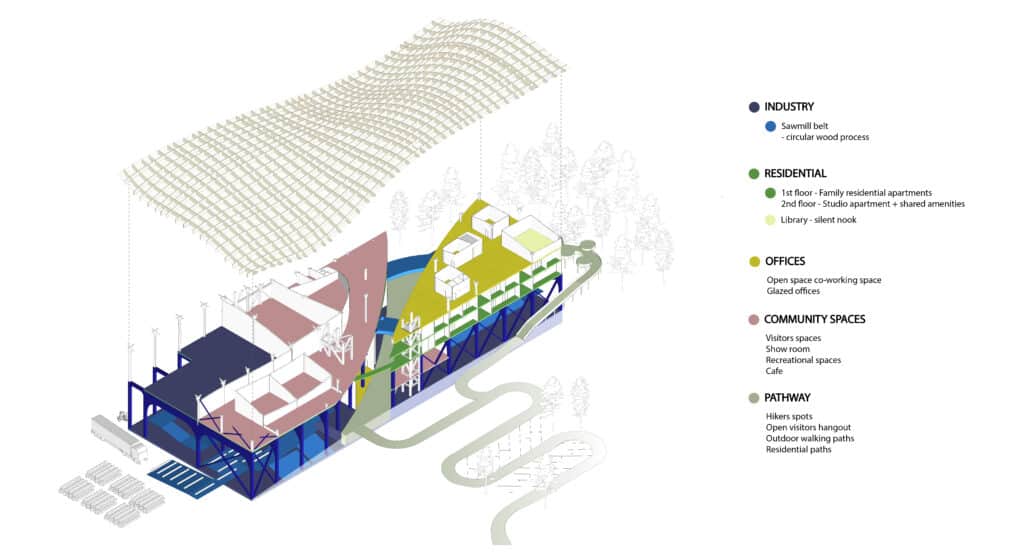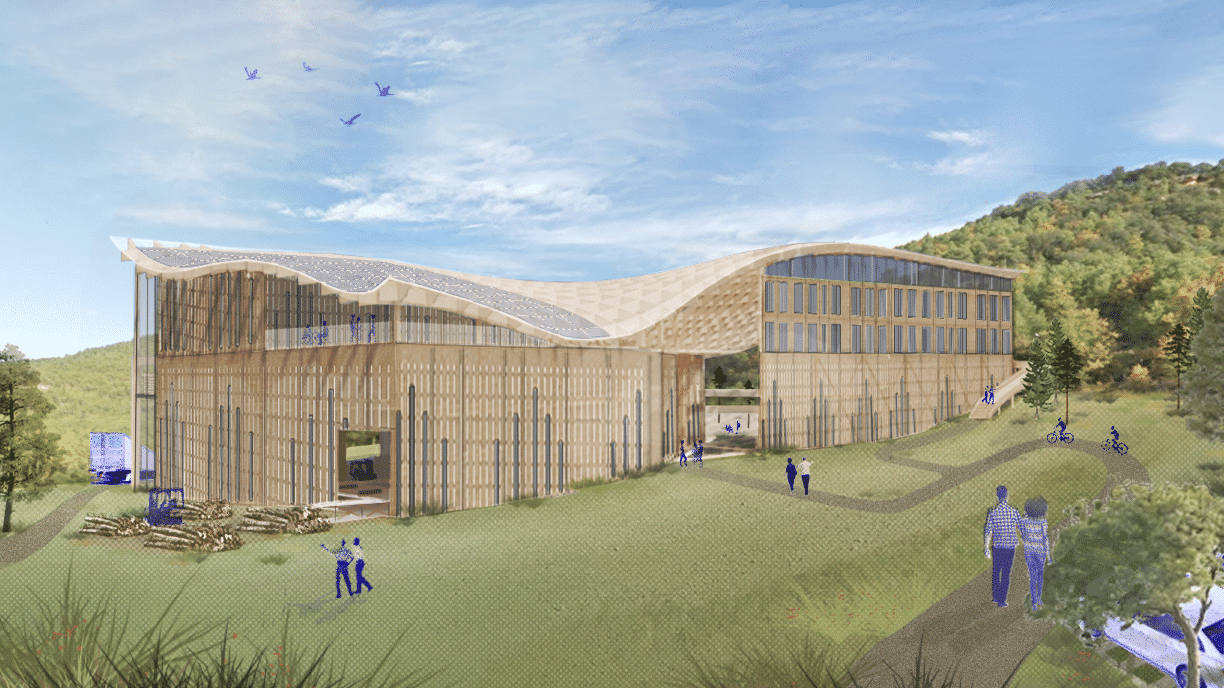Manifesto
From the Pyrenees to Barcelona, the journey wood takes can become a means to bridge the knowledge gap between forests and the timber industry. Solsona, located in the middle of this journey, housing our timber sawmill, can become a place of community and respect for these forests, while engaging people with what happens at large in their region. Nestled along the side of a forest, the circulation and structure of our building is equally influenced by wood as it is by people. The industry, contained predominantly on the first floor, is designed around the pathways of lumber, and on display to any guests who visit. Visitors and staff alike can circulate around the building, seeing the process at all stages. Our structure is divided into two predominant parts in order to incorporate key passive design strategies for the local climate. Ventilation is allowed throughout, with the design of our main central channel and the use of natural materials such as hempcrete help in multiple areas with their thermal inertia. It provides comfort and also use within the manufacturing process of lumber. As a homage to the forests, the main elements of our structural system, arches and columns, attempt to replicate the more natural organic forms we see outside. At the same time, the roof grid is equally as organic, creating its own topography communicating with the landscape of Solsona and acting as a building envelope and thermal regulator.


Site Analysis
At the foothills of the Pyrenees, Solsona is a town of 10,000 inhabitants, surrounded by forests, hiking trails, and a nearby camping site. Our site, set on a sloping terrain, connects the urban edge to the woodland.
The sawmill’s design responds to this transition—its roof form echoes the land’s contours, blending into the landscape. More than just shelter, the structure speaks the language of the sawmill process, bridging the journey of timber from forest to industry to architecture. It reflects the rhythm of transformation—woodlands shaping materials, materials shaping buildings—grounding the sawmill within its natural and urban context.



Thermodynamics and Form shaping
In response to Solsona’s continental climate, our sawmill is designed to adapt to seasonal temperature shifts. The structure is cut in half, creating an open ventilation chamber that enhances airflow while doubling as an exhibition space—a place where timber is displayed like an evolving showcase of material transformation. Visitors can observe the process in a setting that blends industry with public engagement.
To optimize solar gain, the south façade extends outward, maximizing natural light and passive heating. The residential areas incorporate sunrooms, capturing warmth during the cold winter months. Across the structure, temperature zones vary—some spaces remain open and ventilated, while others retain heat for comfort. This flexibility allows the building to adapt to its users and the shifting climate, ensuring efficiency while maintaining a seamless connection between work, exhibition, and dwelling.




Concept Design



A New Industrial Typology
Our sawmill challenges conventional industrial design by blending production, living, and community spaces into a single, multifunctional structure. At its core, the sawmill industry operates on the ground floor, while offices, residential spaces, and public areas are layered above, creating a dynamic exchange between work and daily life.
A visitor showroom and community spaces invite engagement, turning the site into more than just a place of production—it becomes a hub for education, interaction, and innovation. By integrating these typologies, the project redefines how industries function, fostering a more inclusive, adaptable, and transparent relationship between timber processing, architecture, and the people who experience it.

Structure
The sawmill’s structure is anchored by a glulam arch column system, seamlessly connected to the roof structure for strong vertical support. Stability is reinforced through cross-bracing, which originates in the kiln area on the first floor and continues through to the second floor, ensuring structural integrity.
In the east building, designed for residential use, the fourth floor mirrors the second floor of the west building, maintaining a cohesive structural rhythm. Here, tree-like columns branch out, supporting the organic waffle roof structure, which is formed by interwoven GLT beams.
To enhance both function and atmosphere, the roof is covered with a multi-layered bio-based plastic, allowing diffused natural light to filter through, illuminating the space while maintaining protection from the elements. This combination of engineered timber and innovative materials creates a lightweight yet robust system that embodies both efficiency and environmental consciousness.
4o





Envelopes

The façade design emphasizes verticality, reinforcing a connection to the surrounding forest and the natural growth patterns of trees. Inspired by the structural grid of the waffle roof, this vertical rhythm is expressed through the cladding, creating a cohesive architectural language. The use of natural materials, particularly wood, highlights the building’s relationship with the sawmill’s function and enhances its integration into the landscape. Variations in transparency and depth within the façade introduce a dynamic interplay of light and shadow, adding texture while maintaining a strong yet refined presence.


Water & Energy


Our sawmill is designed to generate four times the energy it consumes, utilizing biomass from sawmill waste to power operations. This surplus energy is shared with our CLT factory neighbors and supplied to the Solsona grid, fostering a cohesive and sustainable energy network within the region.
In terms of water, we recognize the high consumption of a heavy industry process. However, our smooth, organic roof design allows us to capture 98% of rainwater, which is then used to supply housing, offices, visitor spaces, and amenities. This efficient water management system reduces our environmental footprint and supports the community’s water needs, aligning with our commitment to sustainability.

Interior Views


Under the organic roof structure, both workers and visitors experience a harmonious connection between the timber process and the surrounding landscape. The design fosters an environment where nature and industry coexist, offering a space that celebrates craftsmanship, sustainability, and the natural beauty of the materials and place.

